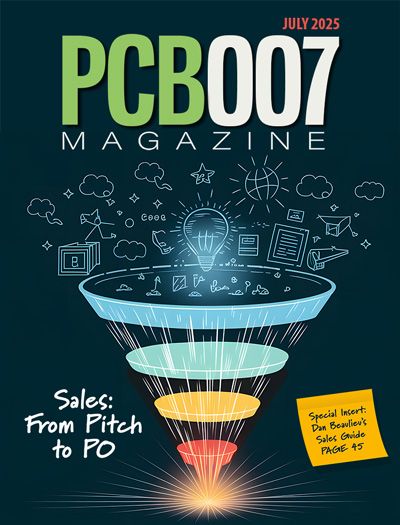-

- News
- Books
Featured Books
- pcb007 Magazine
Latest Issues
Current Issue
Advancing the Advanced Materials Discussion
Moore’s Law is no more, and the advanced material solutions to grapple with this reality are surprising, stunning, and perhaps a bit daunting. Buckle up for a dive into advanced materials and a glimpse into the next chapters of electronics manufacturing.

Inventing the Future With SEL
Two years after launching its state-of-the-art PCB facility, SEL shares lessons in vision, execution, and innovation, plus insights from industry icons and technology leaders shaping the future of PCB fabrication.

Sales: From Pitch to PO
From the first cold call to finally receiving that first purchase order, the July PCB007 Magazine breaks down some critical parts of the sales stack. To up your sales game, read on!
- Articles
- Columns
- Links
- Media kit
||| MENU - pcb007 Magazine
An Insect-Inspired Drone Deforms Upon Impact
July 26, 2018 | EPFLEstimated reading time: 2 minutes
An origami-like drone developed at EPFL is flexible enough to absorb shocks without breaking before returning to its initial shape. This new type of drone, which was inspired by insect wings, draws on the advantages of both stiff and flexible structures.
In recent years, robotics experts have taken a page from the traditional Japanese practice of origami and come up with light and flexible – and highly innovative – robots and drones. Two types of origami-inspired structures have emerged: rigid structures that have a certain weight-bearing capacity but that break if that capacity is exceeded, and flexible yet resilient structures that cannot carry much of a load at all.
EPFL researchers, applying what they observed about insect wings, have developed a hybrid origami drone that can be stiff or flexible depending on the circumstances. When airborne, the structure is stiff enough to carry its own weight and withstand the thrust of the propellers. But if the drone runs into something, it becomes flexible in order to absorb the shock and therefore minimize any damage. This research, which is being carried out in Dario Floreano’s Laboratory of Intelligent Systems, has been published in Science Robotics.
Sandwich Structure
The drone’s resilience comes from a unique combination of stiff and elastic layers. An elastomer membrane is stretched and then sandwiched between rigid plates. When the system is at rest, the plates hold together and give the structure its stiffness. But when enough force is applied, the plates draw apart and the structure can bend.
“When we make a drone, we can give it specific mechanical properties,” says Stefano Mintchev, the study’s lead author. “This includes, for example, defining the moment at which the structure switches from stiff to flexible.” And because the drone builds up elastic potential energy when it is folded up, it can unfold automatically when so instructed.
Structures that are stiff and flexible at the same time have a range of other potential applications as well. As they were developing their drone, the researchers used the same technology to create a soft-touch gripper. The gripper softens once it reaches a certain level of pressure so as not to break the object that it is picking up. This also means it cannot pick up a load that exceeds its capacity.
“The current trend in robotics is to create ‘softer’ robots that can adapt to a given function and operate safely alongside humans. But some applications also require a certain level of rigidity,” says Floreano. “With our system, we have shown that you can strike the right balance between the two.”
Testimonial
"Advertising in PCB007 Magazine has been a great way to showcase our bare board testers to the right audience. The I-Connect007 team makes the process smooth and professional. We’re proud to be featured in such a trusted publication."
Klaus Koziol - atgSuggested Items
Elephantech's SustainaCircuits FPC Adopted for Mass Production in OM Digital Solutions’ Interchangeable Lens
10/06/2025 | ElephantechElephantech Inc. is pleased to announce that its proprietary flexible printed circuits (FPCs) have been adopted for mass production by OM Digital Solutions Corporation in the company’s latest flagship products.
Industry Expert, Mark Finstad From Flexible Circuit Technologies Presents Ask the Flexperts at PCB West
09/22/2025 | Flexible Circuit TechnologiesFlexible Circuit Technologies., Inc/FCT is excited to announce its upcoming session, Ask the Flexperts taking place Thursday, October 2nd, from 9:00–11:00 AM at PCB West 2025. The session will be led by Mark Finstad, Director or Applications Engineering at FCT, who brings over 40 years of experience in the design, fabrication, and testing of flexible and rigid-flex circuits. Mark is an internationally recognized authority in the field, making this a must-attend event for PCB designers, engineers, and industry professionals.
Printed Electronics Market Size to Top $83.77 Billion by 2034 Driven by IoT Adoption and Flexible Device Demand
09/11/2025 | Globe NewswireThe printed electronics market size has been calculated at U$19,920 million in 2025 and is expected to grow from $23,58 million in 2026 to approximately $83,770 million by 2034.
Fresh PCB Concepts: Designing for Success at the Rigid-flex Transition Area
08/28/2025 | Team NCAB -- Column: Fresh PCB ConceptsRigid-flex PCBs come in all shapes and sizes. Manufacturers typically use fire-retardant, grade 4 (FR-4) materials in the rigid section and flexible polyimide materials in the flex region. Because of the small size, some rigid-flex PCBs, like those for hearing aid devices, are among the most challenging to manufacture. However, regardless of its size, we should not neglect the transition area between the rigid and flexible material.
Global Flexible PCB Output Expected to Surpass $20 Billion by 2025, with AI Glasses Emerging as a New Growth Driver
08/25/2025 | TPCAThe Taiwan Printed Circuit Association (TPCA) and the Industrial Technology Research Institute (ITRI) released the "2025 Global Flexible PCB Industry Outlook" in August.


